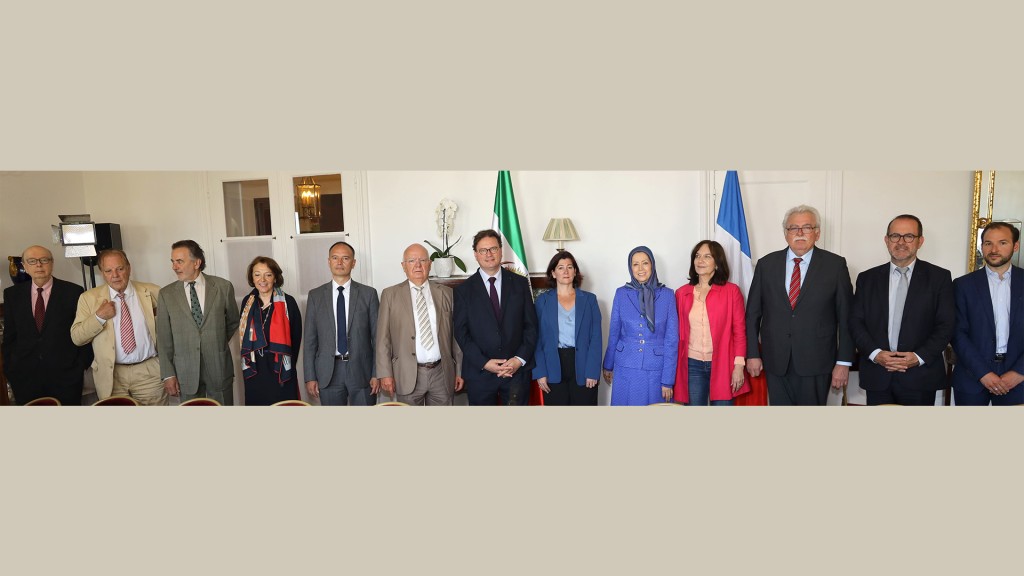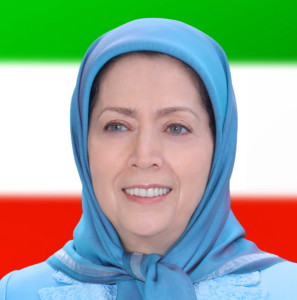Maryam Rajavi: We hope more than ever for freedom in Iran, as we are committed to overthrowing the dictatorship

Addressing a meeting of the Parliamentary Committee for a Democratic Iran at the National Assembly in Paris – May 17, 2023
At the invitation of the Parliamentary Committee for a Democratic Iran (CPID), which brings together French deputies from various political backgrounds, Maryam Rajavi, President-elect of the National Council of Resistance of Iran (NCRI), spoke at a meeting at the French National Assembly in Paris.
Maryam Rajavi was greeted upon her arrival at the Assembly by a group of parliamentarians, including Cécile Rilhac, President of the CPID, Eric Woerth, Quaestor of the National Assembly and former Minister of Budget and Labor, Senator Laurence Rossignol, Vice President of the Senate, and Ms. Annie Genevard, Secretary General of the Republicans Party.
In this meeting, Ms. Rilhac announced a declaration signed by 200 French deputies in support of the Iranian people’s uprising and the 10-point plan for a free Iran of tomorrow.
In addition to the president and vice-presidents of the CPID, such as Mr. André Chassaigne, Philippe Gosselin and Hervé Saulignac, and other deputies and senators, some of the French prominent personalities also participated and addressed the meeting. Among them were Dominique Attias, former vice-barrister of the Paris Bar, Jean-Pierre Brard, former deputy-mayor and one of the founders of the CPID, Jean-François Legaret, former mayor of Paris 1st and president of the Foundation for Middle East Studies (FEMO), Gérard Vespierre, researcher and expert in international politics, and Pierre Bercis, president of the New Human Rights.
During her speech, Mrs. Rajavi said:
Ms. Cécile Rilhac, President of the CPID
Honorable Members of Parliament,
Dear friends,
First, I would like to extend my appreciation to the 200 French deputies who signed the declaration supporting the Iranian Resistance and uprising.
Now, let me address three significant issues. What is the current status of the uprising? What have been the outcomes thus far? And what are the prospects for the future?
Iranian society is currently experiencing an uprising phase
Since January 2018, there have been several significant uprisings in Iran. The latest one demonstrated that the Iranian people were determined to overthrow the clerical regime.
Notably, women have played a leading role in this uprising, guiding and mobilizing the youth in numerous instances of protest. The remarkable involvement of women further signifies the Iranian people’s strong desire for substantial change. They are prepared to endure great sacrifices in their pursuit of freedom.
Tragically, over six months, at least 750 protestors were murdered by the IRGC.
However, despite the relentless repression, the situation remains highly volatile, characterized by a surge in strikes and protests. In recent weeks, workers in the oil, gas, steel, power plants, and copper mining sectors across 38 cities in Iran have initiated strikes.
Additionally, Zahedan, the largest city in the Sistan and Baluchestan province, witnesses weekly protests against the regime after Friday prayers, where demonstrators boldly chant slogans such as “down with Khamenei” and “down with the tyrant, be it the shah or the (mullahs’) leader.”
In response to the uprising and the crises it has caused, the regime has escalated its campaign of executions and repression. Official records since the beginning of May indicate at least 80 announced executions. The actual number, however, is much higher.
Moreover, families of prisoners in Isfahan, Tehran, and Bandar Abas have taken to the streets to protest against the execution of their loved ones.
The outcomes of the uprising
Firstly, the entire regime, particularly Khamenei and his president, has experienced significant weakening. Desertions within the regime’s institutions, particularly the Basij militia, have become increasingly commonplace. Furthermore, the official currency has devalued 17 times since 2015.
Secondly, the regime is not able to quell the uprising. Presently, the slogan “Down with Khamenei” is being echoed by diverse social strata, akin to the “Down with the Shah” slogan during the final months of his reign.
Thirdly, hollow coalitions and false alternatives were swept aside. During the peak of the protests, certain individuals or groups, motivated by personal interests or specific agendas, positioned themselves as the opposition, claiming to be the leaders of the uprising. Some utilized television channels funded by lobbying groups or foreign governments to promote their political shows, proposing the formation of an alternative. Some of these so-called opponents even advocated for cooperation with the IRGC.
Their actions were intended to obstruct the uprising and practically worked against the uprising and in favor of Khamenei’s regime. Within a matter of months, however, they faded into obscurity. As a result of these experiences, Iranian society unequivocally rejected them.
The fourth outcome highlights the clear realization that the driving force behind the uprising primarily consists of young individuals, particularly women, who form the Resistance Units. These units carryied out nearly 3,000 operations to shatter the prevailing repression in the previous year.
In March 2023, the Iranian Resistance disclosed that over 3,600 members of the Resistance Units are either currently imprisoned or have gone missing. Nonetheless, the units have demonstrated resilience by recruiting new members and intensifying their operations.
The Iranian Resistance’s platform
As a result of social discontent and the relentless activities of the Resistance Units, new uprisings are looming on the horizon. The crucial aspect is the organization of the uprising to achieve victory.
Dear friends,
The program of the Iranian Resistance aims to establish a republic characterized by the separation of religion and state, complete individual and social freedoms, gender equality, autonomy for ethnic minorities, the abolition of the death penalty, the prohibition of torture, an independent judiciary system, a free market economy, environmental reconstruction, the dismantling of the IRGC, a non-nuclear Iran, as well as regional and international coexistence and cooperation.
This program is rooted in 44 years of relentless struggle against the oppressive religious dictatorship, with 120,000 martyrs.
European governments, particularly France, must adopt a stance that aligns them with the Iranian people and their ongoing struggle to overthrow the regime.
- Tags: Human Rights, Iran protests, Maryam Rajavi, MEK

